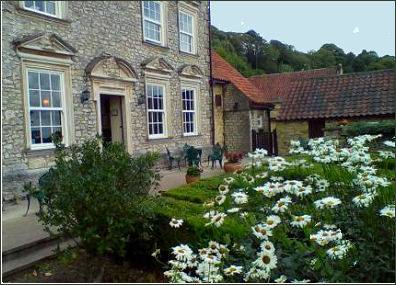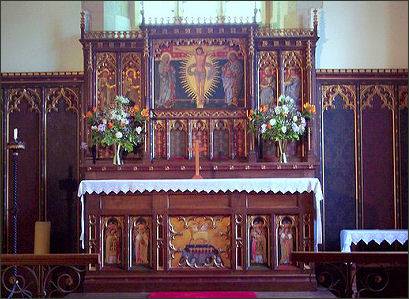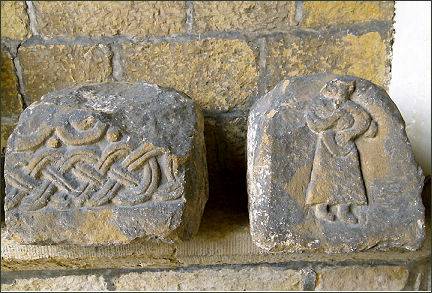Oswaldskirk
OS grid reference:- SE 622 790
 The small, pleasant village of Oswaldskirk lies around 3 miles to the south of Helmsley in the district of Ryedale and around 20 miles north of York. The village is situated to the south of a steep hill, known as "Oswaldkirk Hagg", the last remnant of the western escarpment of the moors..
The small, pleasant village of Oswaldskirk lies around 3 miles to the south of Helmsley in the district of Ryedale and around 20 miles north of York. The village is situated to the south of a steep hill, known as "Oswaldkirk Hagg", the last remnant of the western escarpment of the moors..
The village acquired its name from the church of St Oswald, King and Martyr, an Anglo-Saxon King of Northumbria who who invited Saint Aidan to establish the monastery of Lindisfarne and was slain at the Battle of Maserfield, by the pagan, Penda of Mercia in 642. There is also a Catholic church, dedicated to St Aidan.
The word "kirk" means church, so the village is literally called Oswald's church. The first recorded mention of Oswaldkirk occurs in the Domesday Book of 1086 were it is referred to as "Oswaldecherca" or "Oswaldecherce".
The village pub, the Malt Shovel (pictured righht) is situated on Main Street is a Grade II listed building and dates back to around 1720. The characterful building boasts log fires, beams and flagstones and serves excellent meals. It is reputed to be haunted by the ghost of a little boy, Thomas Bamber, who died more than a century ago, aged only five.
The village holds a Safari Lunch annually and also a Cricket match and a Bonfire. Every two years there is a benefice Hog Roast.
The village lies on the path of the Ebor Way which runs for 70 miles (113km) from nearby Helmsley to Ilkley in West Yorkshire.
The Church of St. Oswald King and Martyr
The church of Saint Oswald King and Martyr dates back over 900 years. The building occupies the site of a wooden Saxon church, almost nothing of the original church survives to the present day, with the exception of some unique examples of Celtic stonework, including a plait interweave and a bas-relief of the Virgin and Child, which was carved around 1000 AD. The current building still has a quoin, which was probably a re-cycled Anglo-Saxon cross shaft.


The Norman stone entrance to the church was built in the twelfth century. The tall windows set in the church wall both north and south of the nave have been dated to around 1320 to 1330, and small fragments of medieval glass can be found. in the top sections of two of the windows. A tombstone under a low arch on the inside of the southern wall is generally believed to be that of Sir Richard Pickering (d. 1441), who left his green coat to be made into a vestment for Saint Oswald's altar and was a member of the Pickering family who ruled Oswaldkirk from the fourteenth to the sixteenth century.
The gravestone of a Cistercian abbot lies in the North East corner of the sanctuary which occupied a position in front of the altar until 1886. Whether an abbot of Byland or Rievaulx is buried here is unknown, it is possible that the stone may have been brought to Oswaldkirk at the time of the Dissolution of the Monasteries.
John Dee, a notable rector of the church, who served from early 1568 until the year 1574, was a noted mathematician, astrologer, alchemist and astronomer, was on friendly terms with Queen Elizabeth I. He gave her astrological advice for setting the date of her coronation. The future Archbishop of Canterbury and chaplain to King Charles II, John Tillotson, preached his first sermon at the church of Saint Oswald in 1661.
A major restoration of the building was carried out in 1886, and a large amount of the Chancel woodwork dates from this period. During the restoration the east window was also replaced; it now depicts the stylised form of Saint Oswald, flanked on either side by Saint Aidan, and Saint Cuthbert, both Christian saints of the same era, and who helped him in missionary work in the Kingdom of Northumbria
These windows are directly opposite the western window which depicts Queen Victoria. Further modern additions to the church can be seen in the bell turret and organ chamber, as well as the south porch.
